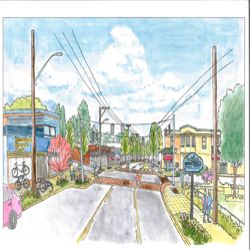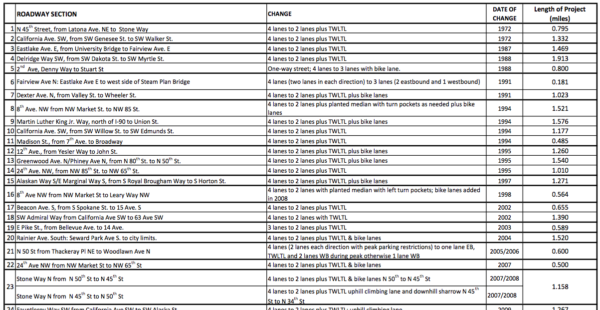 The recent article on the progress of the Montlake Business District Development project has generated several comments about the proposal to reduce traffic lanes from four to three on 24th Avenue E (the “road diet”). The general concern is that this change could result in worsening the traffic back-ups on 24th Avenue E and increase more cut throughs on our residential streets. Certainly none of us want this to happen, and a “road diet” would not occur until SDOT studies its possible effects on cut-through traffic.
The recent article on the progress of the Montlake Business District Development project has generated several comments about the proposal to reduce traffic lanes from four to three on 24th Avenue E (the “road diet”). The general concern is that this change could result in worsening the traffic back-ups on 24th Avenue E and increase more cut throughs on our residential streets. Certainly none of us want this to happen, and a “road diet” would not occur until SDOT studies its possible effects on cut-through traffic.
According to the Walkable and Livability Institute: “Drivers tend to use primary roads that provide the most direct and efficient route to a destination. Well- designed road diets do not divert drivers onto other roads. While traffic often drops during construction, it typically returns to normal or increases within six months of completion. “
Since the 1970’s The Seattle Department of Transportation has completed 40 neighborhood projects that included right sizing or road diets. (Download this PDF to see a List of Projects.) They have found that these “rechannelizations” (or road diets) actually reduce speeds and collisions. They are especially beneficial and safer for pedestrians since they have fewer lanes to cross. It is critically important to ensure we all, especially children, have a safe way to schools, park facilities, transit and shopping. The City has found that significant amounts of diversions do not occur. If it does happen, they can use traffic calming devices like speed bumps, traffic circles or diverters to discourage cut-through traffic.
The reality is that we are an urban neighborhood and traffic will not go away. The entire city is now that way. To reduce congestion the city would need to add capacity with roadway widening and more traffic lanes which it will not do and would not work if we want to have livable residential areas in the city. The city’s policy is shared use streets, providing multi-modal transit and bicycling facilities and making streets safer and more comfortable for pedestrians by reducing speeds and narrowing intersections where they can. The overall result is that commuters have to adapt, use bus or bike instead of cars and understand the commute drive will take more time.
That said, if we want a safe and viable business district that serves and is connected to the Montlake community, we need to find ways to reduce speeding on the 24th arterial which is dangerous to pedestrians, and we need to find ways to support and enhance our business district. Adopting the “road diet” promises to do both if the results of SDOT’s traffic study show Montlake is eligible for this change.
As a longtime resident (living at the corner of 25 Avenue E. and E. Miller Street for 40+ years) I know the frustration of traffic and understand the fear that slowing down traffic in one area can have the unintended consequences of drivers “discovering more convenient routes.” The solution is to develop a traffic calming plan for the residential streets. Representatives from the Montlake Community Club continue to meet with SDOT to discuss this matter. Our goal is to develop a neighborhood wide plan that will eliminate cut through traffic. We will be reaching out to the community to identify the best ways to achieve this goal on a street to street basis.
Living in Montlake should not mean sacrificing the opportunity to develop our business district for fear of increased traffic. We, as a community, are organized and working to find solutions. We want any changes made to re-energize the Montlake business district to work for the entire community.

